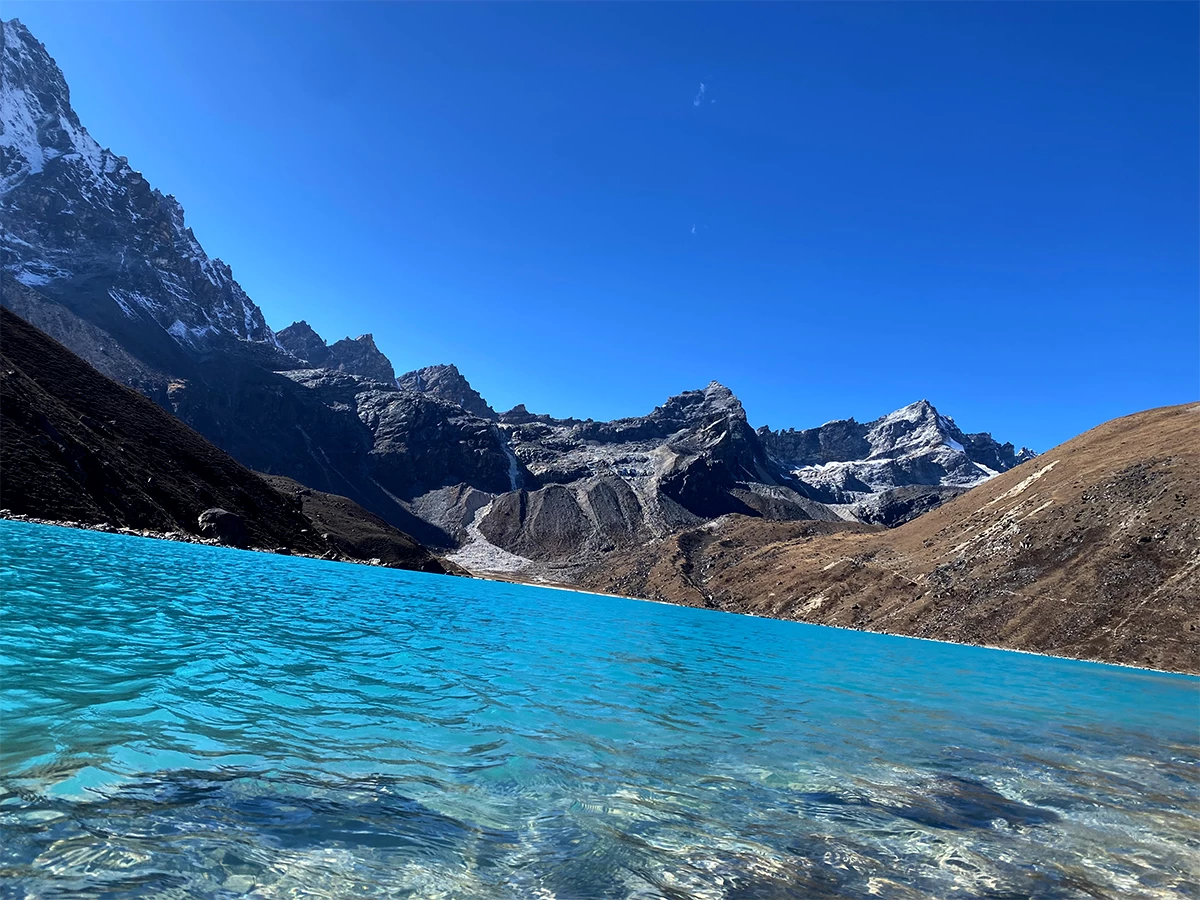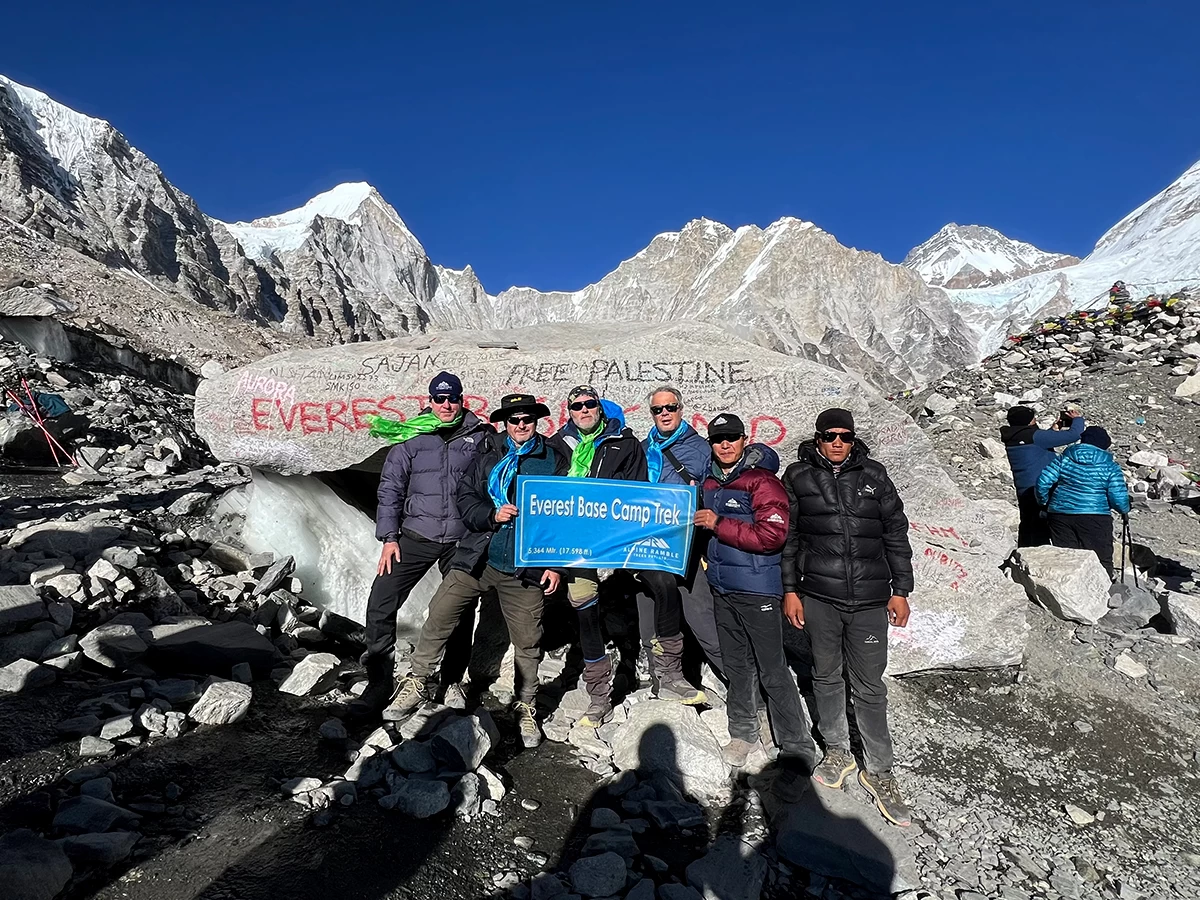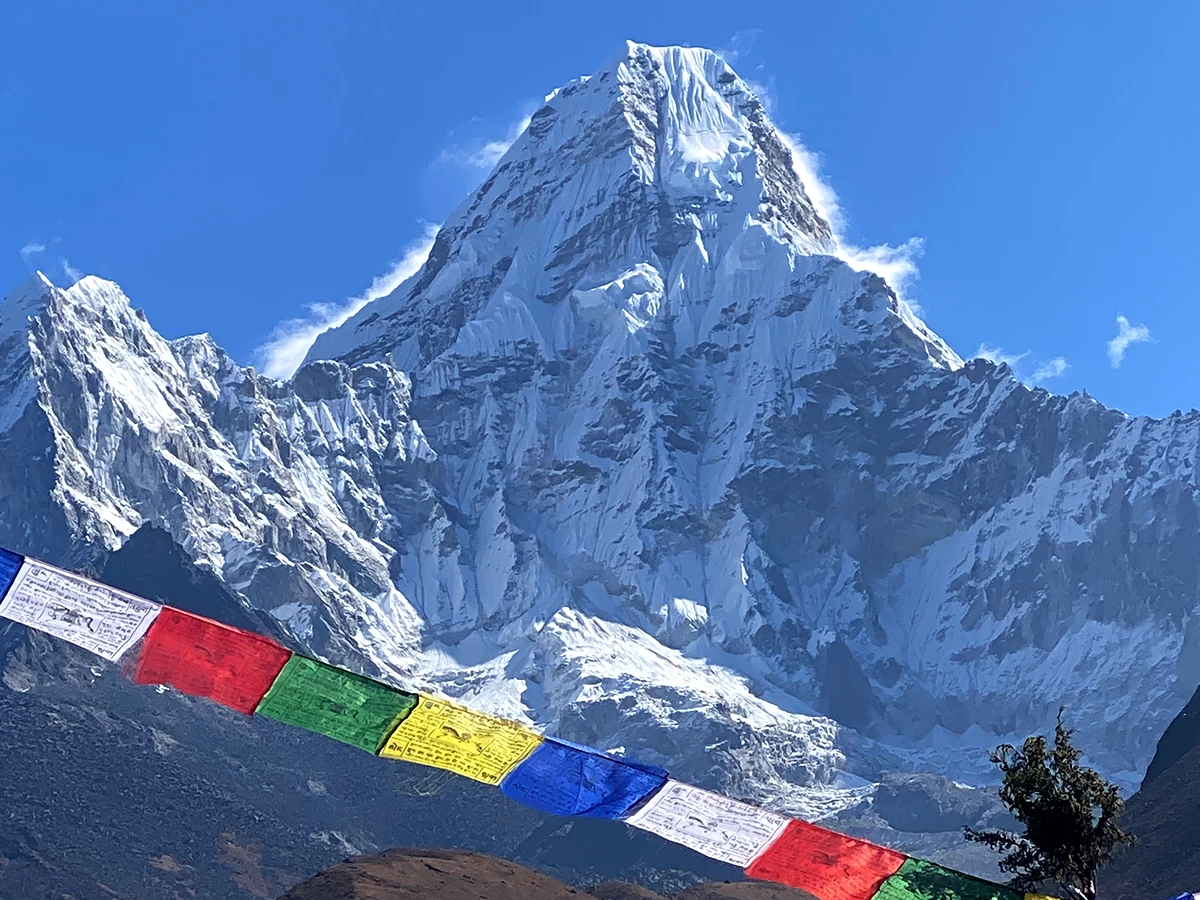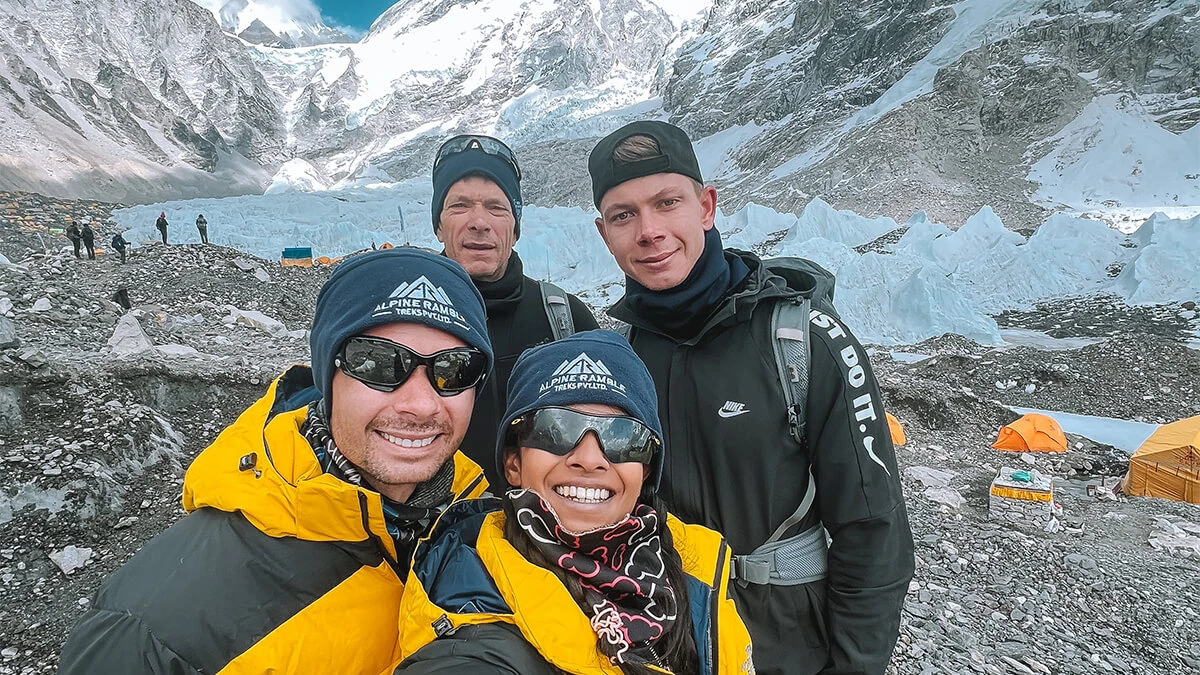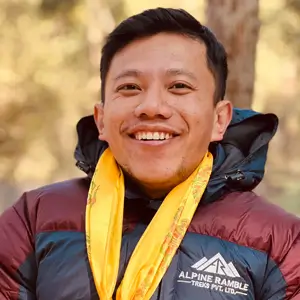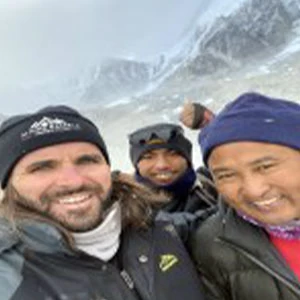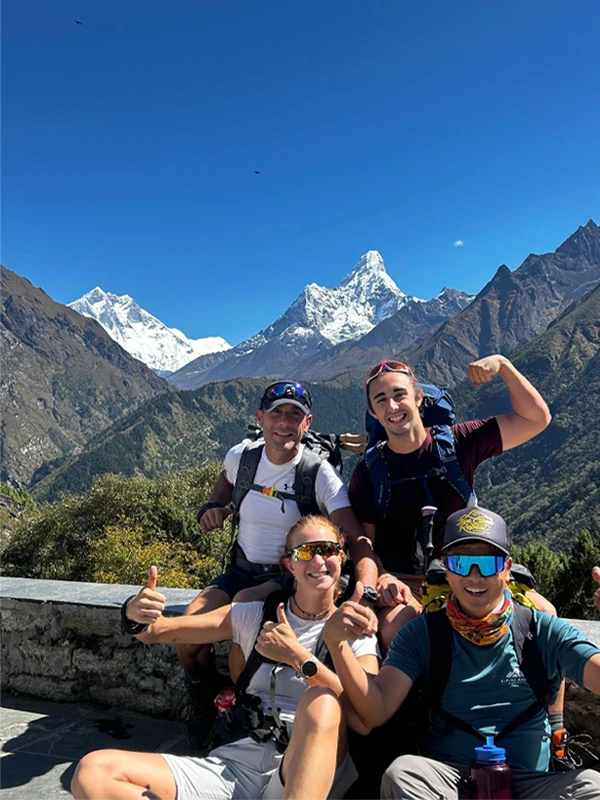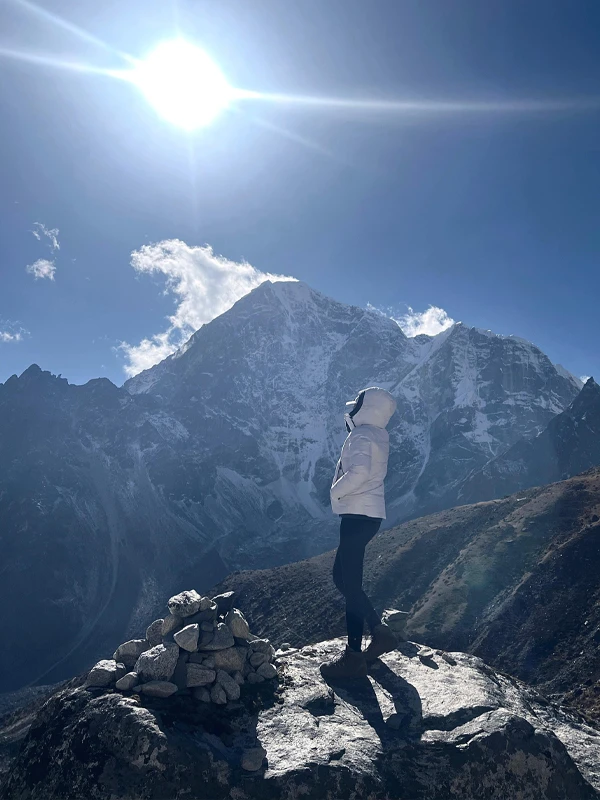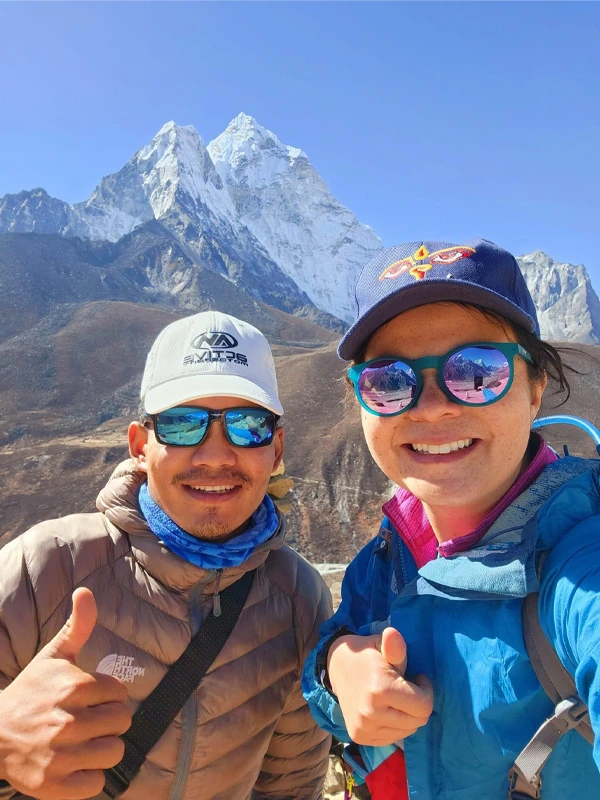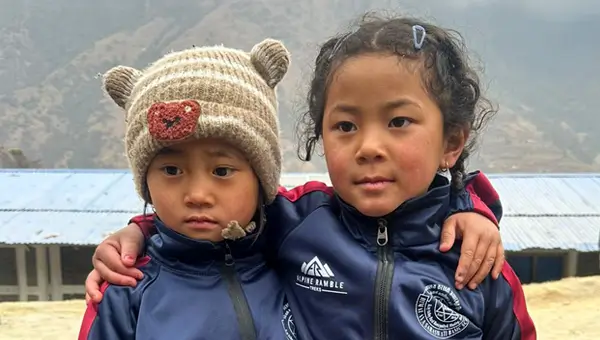Comfort, Culture & Safety on the Trail
Luxury isn’t the absence of challenge; it’s the comfort woven into it.
Teahouses, Warmth & Real Hospitality in Gokyo Trek
If Switzerland has its chalets, Nepal has its teahouses, rustic on the outside, profoundly human inside. Every stop along the Gokyo Lakes trail, from Phakding to Machhermo, has family-run lodges where the concept of hospitality is older than tourism itself.
When a Nepalese host pours tea for you, it’s not service, it’s welcome. In Sherpa, Tamang, and Rai cultures, guests are considered blessings (“Atithi Devo Bhava”, an ancient Sanskrit phrase meaning the guest is god).
Firewood crackles in the stove room; yak-butter lamps flicker beside thermoses of lemon-ginger tea. You’ll sit among trekkers from six continents, trading stories over plates of hot momos or apple pancakes, feeling that rare balance of adventure and belonging.
Alpine Ramble curates your stays with precision: clean rooms with twin beds, thick blankets, heated common areas, and kitchens verified for hygiene and altitude-safe menus. In Namche and Gokyo, premium lodges offer ensuite hot showers, charging points, and Wi-Fi strong enough to send that summit photo home.
Meals: Where Nutrition Meets Nepalese Heart
Each meal on the trail is an event, both practical and poetic.
Mornings begin with porridge, pancakes, or eggs beside steaming mugs of Himalayan coffee. Lunches are hearty: vegetable noodles, fried rice, lentil soups rich in salt and warmth. Dinners often feature dal bhat, Nepal’s national meal: rice, lentil soup, curry, sautéed greens, and pickles, a power combo locals call “Dal Bhat Power, 24 Hour.”
For those craving variety, the menus in Namche and Gokyo include Sherpa stew, Tibetan bread, apple pie, spaghetti, and even cappuccinos made with solar-powered espresso machines at 4 000 meters.
Alpine Ramble emphasizes balance: carbs for altitude, soups for hydration, herbal teas for sleep. The guiding team ensures your diet complements the climb, and filtered water (or refill stations) keeps you hydrated without single-use bottles.
Luxury Beyond Material: The Psychology of Space in Gokyo Lake Trek
Luxury in the Himalayas isn’t marble, it’s mindspace. It’s a warm blanket after a cold climb, a silence so deep you can hear avalanches crack miles away, and mornings when prayer flags move before the sun does.
At Gokyo, the lake mirrors the stars, and you may realize no spa or skyline has ever felt this complete. Travelers from Europe and America often describe it as “the kind of peace you thought didn’t exist anymore.”
Your helicopter finale embodies this ethos. The return flight is a curtain call: an uninterrupted 40-minute Himalayan symphony where time slows, peaks align, and reflection begins. It’s an act of grace, a luxurious alternative to retracing miles when your spirit already feels full.
Safety, Support & Serenity
In the Himalayas, luxury begins with confidence. Alpine Ramble’s guides are licensed, insured professionals, many with 15–20 years of experience, trained in altitude management, wilderness first aid, and cultural interpretation. They’re locals not just by birth but by bond; these trails are their childhood playgrounds and their lifelong pride.
Each trek includes:
- Daily health monitoring with oximeter readings
- Smart pacing for altitude acclimatization
- On-demand porter support (24 kg shared load)
- Backup oxygen cylinders and first-aid kits
- Access to health posts in Namche and Machhermo
- Helicopter evacuation logistics, pre-cleared via insurance
This structure lets you focus on awe, not logistics.
When a company has guided 15 000+ trekkers with a 100% success record, safety isn’t a department—it’s a culture.
Eco-Ethics & Community Connection
Every Alpine Ramble journey carries a deeper footprint of respect. We minimize waste, favor locally owned lodges, and encourage trekkers to refill bottles at filtered water stations.
Porters receive fair pay, warm gear, and insurance. A portion of every booking supports education initiatives in rural Solukhumbu, keeping the next generation connected to the region’s legacy.
Luxury here means leaving the trail better than you found it. When you share a laugh with a porter or buy handwoven yak wool from a Namche artisan, you’re participating in something older than tourism, the Himalayan economy of dignity and exchange.
Life on the Trail: 7-Day Gokyo Lakes Heli Adventure
Who Can Trek the Gokyo Lakes Route?
(This isn’t a race to altitude, it’s a return to wonder.)
Families with Curious Kids (8 and above)
Children see things adults forget. Prayer wheels become spinning toys of compassion, yaks become real-life storybook creatures, and bridges sway like carnival rides. Parents say this journey out-teaches any classroom, about geography, humility, and joy.
Alpine Ramble tailors daily pacing, mealtimes, and room selection for families. Every evening ends warm, fed, and laughing by the fire. The helicopter return makes it manageable, seven days, endless stories.
Couples & Solo Dreamers
Private departures are crafted for those who crave shared silence, sunrise over Gokyo mirrored twice, in water and in eyes. Couples celebrate honeymoons, anniversaries, or simply promise themselves “time away from the noise.”
Solo travelers find safety and soul-company in their local guide in Nepal, who becomes confidant, interpreter, and friend. Every shared cup of masala tea bridges continents.
Seniors & “Golden Birthday Trekkers”
In the Khumbu, age is not an obstacle, it’s a badge of grace. Many of our travelers in their 60s and 70s call this “the most life-affirming thing I’ve done.” With measured pacing, porters for comfort, and nights spent in heated lodges, it’s achievable and deeply moving.
Imagine your 70th birthday toast in Namche Bazaar (3 440 m), prayer flags fluttering like confetti.
Corporate Retreats & Leadership Teams
The 7-day Gokyo Lakes Trek with helicopter return is becoming Nepal’s premier executive experience. Leadership teams from the US, UK, Japan, and Australia have trekked this route as a metaphor for alignment, shared effort, clear goals, and reflection.
The helicopter finale over Everest Base Camp doubles as both boardroom and cathedral, proof that perspective beats any seminar. Alpine Ramble arranges branded gear, logistics, and luxury teahouse stays for comfort without losing authenticity.
Photographers & Seekers of Stillness
This trek is less about conquering altitude and more about capturing light, the indigo dawn on Cho Oyu, the mirror-flat stillness of Gokyo’s 3rd Lake.
For visual storytellers, this is Nepal’s Louvre in motion. For spiritual travelers, it’s a walking prayer. The helicopter return completes the circle, you see from above what your feet have honored below.
Daily Life on the Gokyo Trail: Luxury in the Language of Simplicity
Teahouses: Nepal’s Heritage of Hospitality
Forget sterile hotels. Think Swiss-style mountain lodges, timber-paneled, family-run for generations. Each evening, the fire crackles with stories in many accents, a German climber, an Australian teacher, a Nepali grandmother who still hand-spins wool.
Alpine Ramble books the best lodges: ensuite where possible, always warm, always clean. The real luxury isn’t thread count; it’s the sincerity in a host’s “Namaste.”
Cuisine: From Dal Bhat to Divine Apple Pie
Meals are slow, hearty, and made from scratch. Dal bhat (steamed rice, lentil soup, vegetables) is the heartbeat, unlimited servings, balanced energy. Breakfasts feature Himalayan honey pancakes and Sherpa bread. Dinner may surprise with chocolate pudding or yak-cheese pizza.
Western trekkers find it cleaner than many city diets, organic by geography, not marketing. In Namche, coffee from Illy beans and apple pie rival Vienna’s café culture.
Water & Well-Being
Purify, refill, repeat, that’s the rhythm.
Hydration target: 3.5–4 liters a day.
Bottled water is available, but we encourage purification tablets or UV filters to reduce waste. The body thanks you, and so does the planet.
Electricity & Connectivity
Hydropower hums up to Namche; solar panels take over higher. Charging: USD 3–5 per device per charge, a small luxury for your camera and connection.
Wi-Fi via Everest Link (USD 5–10) works in most lodges. Mobile signals reach Dole, sometimes Machhermo.
But most guests soon realize: the fewer notifications, the more you notice yourself.
Evenings in the Himalayas, Where Silence Becomes Soundtrack
Dinner 7 pm. Firelight. Laughter. Maybe a Sherpa guide humming a folk tune about home and high passes.
Outside, the Milky Way spills like prayer beads. Inside, you’re warm. It’s the kind of stillness luxury hotels try to design, but here, it just exists.
Is This 7-Day Gokyo Lakes Heli Trek Right for You?
Who Gets the Most Out of This Journey?
1 Busy Professionals & Entrepreneurs with a Week Off
You’ve conquered boardrooms; now let a mountain humble you. Seven days is all it takes, a long weekend stretched into transcendence. You land in Kathmandu Sunday, trek Monday, return by helicopter Saturday.
One week later, you’re back at your desk, yet part of you never quite returns. Alpine Ramble manages the timing down to the minute: flights, permits, and the perfect weather window.
2 Adventurous Couples & Anniversary Seekers
Romance redefined: morning tea at 4 900 m, prayer flags fluttering like vows renewed. Couples choose this itinerary because it’s challenging, yet civilized, trek by day, sip wine by the stove by night.
The helicopter finale over Everest Base Camp is your shared cinematic ending. Some call it “the world’s highest honeymoon.” We simply call it perspective.
3 Solo Travelers & Story Collectors
You don’t come to the Himalaya to get lost, you come to find something. Solo trekkers love the rhythm: walk, breathe, reflect, repeat. Every encounter, a monk’s smile, a child’s laughter, a porter’s wave, adds a paragraph to your story.
Alpine Ramble’s local guide in Nepal walks beside you, translating both language and silence. Many return saying, “I arrived alone, but I never felt lonely.”
4 Photographers & Visual Explorers
If you’ve captured Patagonia or the Alps, Gokyo is your Everest of reflection. The turquoise lakes mirror six of the world’s tallest peaks. Light changes by the minute, from steel-blue mornings to amber dusk.
Helicopter return lets you photograph the ranges from above, an aerial ballet of ice, shadow, and wonder. No filter equals the real air at 5 000 m.
5 Spiritual Seekers & Mindful Travelers
For some, this trek is pilgrimage, not fitness. Every mani-wall, every stupa, every whispered “Om Mani Padme Hum” feels like walking meditation. The rhythm of your steps matches the valley wind.
At Gokyo’s third lake, people often sit for an hour, not for photos, but for silence. It’s said even Everest bows to peace here.
When to Choose the Gokyo Lakes Heli Trek (2025 / 2026)
Spring (March – May): Rhododendron Dreams
Forests ignite with crimson blossoms; trails hum with life. Snow lines recede, revealing fresh alpine greens. Visibility is crystal-clear — ideal for aerial photography. Temperatures range 10 °C (50 °F) to -10 °C (14 °F). Perfect for first-timers seeking balance between beauty and comfort.
Autumn (September – November): The Classic Window
Crisp mornings, stable weather, and cultural festivals. You’ll likely catch glimpses of Mani Rimdu at Tengboche Monastery — monks dancing blessings for the season. Sky color: impossibly cobalt. This is peak luxury-trek season, so book 3–4 months ahead.
Winter (December – February): Solitude & Stars
Only the committed come now — rewarded with silence and silvered valleys. Lodges are warmer than you think; stoves glow, hosts linger longer over tea. Alpine Ramble provides extra insulation and private porter service. This is the season of introspection and celestial photography.
Summer (Monsoon June – August): Emerald Adventure
For travelers unfazed by rain, this is Nepal at its lushest. Valleys glisten, waterfalls multiply, trails quieten. The helicopter ride becomes cinematic — clouds parting around Everest like theater curtains. We recommend it for experienced hikers or repeat visitors craving intimacy with nature.
If You’re Already in Kathmandu (“Start Tomorrow” Mindset)
Nepal favors the spontaneous. Permits for Sagarmatha National Park and TIMS can be arranged in hours. Alpine Ramble’s guide meets you at your hotel, checks your gear, handles logistics. Quality down jackets, sleeping bags, and poles are rentable in Thamel for under USD 100 total.
Morning flight to Lukla, afternoon trek to Phakdin, by sunset, you’re already walking the dream.
Few experiences turn jet-lag into awe this quickly.
Suggested Age Range & Preparation Plan
Ideal age: 10 to 70+, with moderate fitness. You don’t need a triathlon medal; you need consistency. If you can walk 5–6 hours/day at sea level, you’re ready. Seniors thrive here, slower pace, lower daily gain, helicopter exit.
Families train together: weekend hikes, light stair climbs, shared playlists. Preparation tip: 2 months out, start walking hills 3–4×/week; focus on breathing more than speed. Altitude rewards rhythm, not racing.
Why It Fits So Many Travelers
The Gokyo Lakes Heli Trek compresses what most Everest journeys take 12–14 days to deliver, in half the time, without cutting the soul. It’s for those who want the Himalayas to feel not like a test, but a dialogue. For those who prefer quiet comfort over crowds and an eagle’s-eye return over a rush descent. And for those who believe time isn’t just spent, it’s transformed.
Preparation, Comfort & How Alpine Ramble Makes It Effortless
Luxury in Rhythm, Not Excess
Luxury in the Himalayas isn’t gold taps or infinity pools: it’s the right pace, the right people, and the right peace. It’s having a local guide in Nepal who senses when you need a pause before you even ask. It’s drinking ginger tea above the clouds, knowing every detail, from permits to porter loads, is already taken care of.
At Alpine Ramble, we believe in what we call “Effortless Adventure.” That means meticulous logistics, safe pacing, and comfort that doesn’t isolate you from authenticity. You’ll still feel the wind, the altitude, the heartbeat of the trail — but you won’t feel lost in it.
Your Comfort Zone, Reimagined at Altitude
Accommodation & Warmth
Our teahouse network is curated from 15+ years of partnerships across the Khumbu. Rooms are twin-share, wood-paneled, with private bathrooms where available and shared ones spotless where not.
Heated dining halls, thick blankets, and genuine smiles come standard. At Gokyo, you’ll stay by the lake’s edge, imagine sipping tea while Cho Oyu (8,188 m) blushes under sunrise.
Food & Fuel
Nutrition is central to energy and acclimatization. We ensure balanced meals: dal bhat for sustained power, fresh vegetables, pancakes, soups, yak cheese, and apple pie that tastes of home.
Coffee lovers rejoice, Illy beans and espresso machines have reached Namche. For comfort trekkers, we prearrange hygienic meal plans; for food lovers, we add authentic Sherpa kitchen visits.
Water, Power & Connectivity
Filtered or bottled water available everywhere. Bring a reusable bottle; it’s not just eco-responsible, it saves money and conscience. Charging: USD 3–5 per device. Wi-Fi via Everest Link (USD 5–10 per session). Mobile network covers Lukla to Machhermo; beyond, your camera and consciousness do the connecting.
Evening Routine
Dinner 7 PM.
Shared laughter, mountain stories, and gentle music fill the lodge. Then, step outside. The stars over Gokyo are so bright, most guests instinctively whisper. It’s not luxury made, it’s luxury found.
The Art of Preparation (Western Traveler’s Edition)
You don’t need to be an athlete; you need to be aware. Start with 6 weeks of prep: light, consistent, and mindful.
Weeks 1–2:
Four sessions per week: 45 minutes of brisk walking, cycling, or light jogging. Add weekend hikes of 2–3 hours.
Weeks 3–4:
Increase to 5 sessions a week.
Add a loaded daypack (~6–8 kg / 13–18 lbs).
Try hill climbs or stairs twice a week.
Weeks 5–6:
Do one “back-to-back” weekend (Sat–Sun) with 4–6 hours of walking per day. Train at conversation pace — you should be able to talk, not gasp.
Hydration habit: 3–4 liters daily.
Sleep: 7+ hours.
Mental prep: watch Everest documentaries, not to compare, but to connect.
Medical & Fitness Notes
If you have heart, lung, or blood-pressure conditions, get clearance from your physician. Altitude affects everyone differently, our pacing minimizes risk. Your local guide carries a pulse oximeter and checks oxygen saturation daily. Helicopter evacuation options are always available through insurance.
Packing Like a Pro (or Like You’ve Done This Before)
Essential Gear (We Provide on Request)
- Warm sleeping bag (up to -20°C rated)
- Down jacket
- Trekking poles
- Duffel bag for porter carry
Personal Gear
- Comfortable trekking boots (broken-in)
- Thermal base layers + fleece midlayer
- Insulated jacket + waterproof shell
- Trekking pants (2 pairs), gloves (2 types), buff, sunhat
- Sunglasses (UV-rated), SPF 50+, lip balm
- Reusable bottle, hydration bladder
- Power bank, universal adapter, headlamp
Extras for Luxury Trekkers
- Lightweight camp slippers
- Mini French press or Aeropress (for coffee lovers)
- Silk sleeping liner
- Kindle or journal
- Compact binoculars (for Himalayan wildlife spotting — Himalayan tahr, musk deer, lammergeier eagles)
Packing tip: Bring curiosity, leave expectations.
Every ounce of openness weighs lighter than overpacked gear.
Money, Cards, and Cash
- Kathmandu: ATMs and cards accepted.
- Namche Bazaar: Has ATMs (carry backup cash).
- Above Namche: Cash only (Nepali Rupees). Plan NPR 3,000–4,000/day for personal extras (Wi-Fi, charging, showers, tips, snacks).
Exchange currency in Kathmandu for best rates. Carry small notes (100s, 500s) for trail convenience.
Insurance: Peace of Mind
Every luxury traveler knows, real confidence is insured confidence. You’ll need travel insurance covering trekking up to 5,500 m and helicopter evacuation. Popular providers: World Nomads, SafetyWing, TrueTraveller (EU/UK), and Allianz (US/AUS).
Keep one copy on your phone, one with your guide. Nepal’s air evacuation teams operate 24/7, faster than most European rescue systems.
